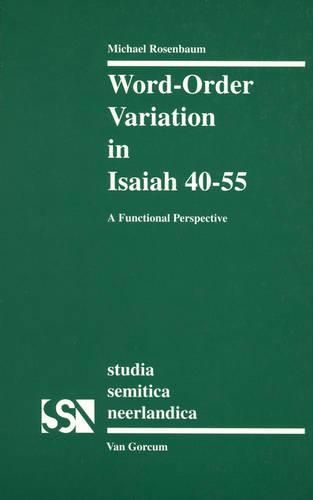Readings Newsletter
Become a Readings Member to make your shopping experience even easier.
Sign in or sign up for free!
You’re not far away from qualifying for FREE standard shipping within Australia
You’ve qualified for FREE standard shipping within Australia
The cart is loading…






What is the significance of word-order variation in Isaiah 40-55? This work attempts to answer that question through the application of a functional linguistic model. A model is outlined which is drawn primarily from Functional Grammar and a metalanguage is developed which also incorporates insights and terminology from Prague School linguistics and Discourse Analysis. According to this model, all languages develop a basic functional pattern into which constituents are placed in a consistent, familiar order according to the function which those constituents serve in a discourse context. Additionaly, languages develop special positions which can be used to mark constituents with certain functions (Topic, Theme, Setting, Focus, Tail, Vocative and Parenthetical). A functional pattern (the basic pattern plus the special positions) is outlined for the language of verbal clauses in Isaiah 40-55. Also, rules are written which describe the placement of constituents in the functional pattern. Each of the functions outlined in the model and defined in the metalanguage is illustrated in the language of Isaiah 40-55. Finally, there is a chapter which outlines the many defamiliar, or poetic, patterns found in Isaiah 40-55 due to the foregrounding of the language. In conclusion, it is observed that the order of constituents in the language of Isaiah 40-55 frequently does not emulate the basic functional pattern. Two explanations are demonstrated for this phenomenon: first, Deutero-Isaiah makes frequent use of special positions to mark certain functions; and second, the language of Isaiah 40-55 is foregrounded, or poetic, and highly defamiliarizing.
$9.00 standard shipping within Australia
FREE standard shipping within Australia for orders over $100.00
Express & International shipping calculated at checkout
What is the significance of word-order variation in Isaiah 40-55? This work attempts to answer that question through the application of a functional linguistic model. A model is outlined which is drawn primarily from Functional Grammar and a metalanguage is developed which also incorporates insights and terminology from Prague School linguistics and Discourse Analysis. According to this model, all languages develop a basic functional pattern into which constituents are placed in a consistent, familiar order according to the function which those constituents serve in a discourse context. Additionaly, languages develop special positions which can be used to mark constituents with certain functions (Topic, Theme, Setting, Focus, Tail, Vocative and Parenthetical). A functional pattern (the basic pattern plus the special positions) is outlined for the language of verbal clauses in Isaiah 40-55. Also, rules are written which describe the placement of constituents in the functional pattern. Each of the functions outlined in the model and defined in the metalanguage is illustrated in the language of Isaiah 40-55. Finally, there is a chapter which outlines the many defamiliar, or poetic, patterns found in Isaiah 40-55 due to the foregrounding of the language. In conclusion, it is observed that the order of constituents in the language of Isaiah 40-55 frequently does not emulate the basic functional pattern. Two explanations are demonstrated for this phenomenon: first, Deutero-Isaiah makes frequent use of special positions to mark certain functions; and second, the language of Isaiah 40-55 is foregrounded, or poetic, and highly defamiliarizing.